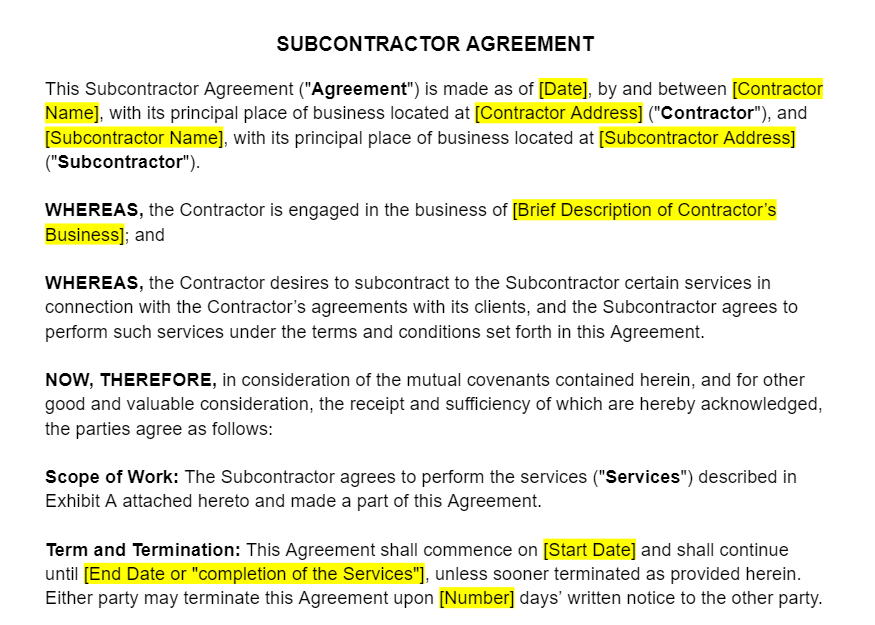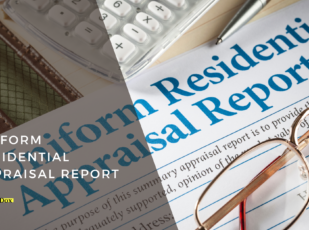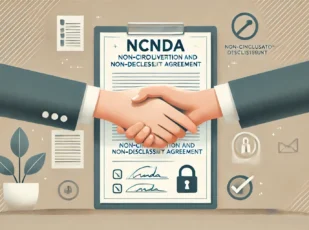
Subcontractor Agreement Template
4 Downloads
Commercial
January 11, 2025
Sayantani Dutta
Project execution and collaboration have become the cornerstones of the modern economy. As the world gets more specialized—with service providers and different types of vendors handling a good chunk of work required by organizations and businesses that do not wish to hire in-house personnel for everything, it has become quite common to rely on them. An independent contractor or a freelancer sometimes offers services in collaboration with other contractors or freelancers. These are called subcontractors. When a contractor subcontracts to another individual, team, or agency, it needs a Subcontractor Agreement.
This agreement is a critical instrument in defining the working relationship and the operating guidelines between a contractor and a subcontractor. In most cases, the actual client does not need to deal with the subcontractor—so the entire responsibility falls on the contractor. For example, if there are quality standards or tight timelines to be met, the contractor is 100% accountable.
So, when subcontracting work out to another, it is important to specify duties, scope of work, compensation frameworks, and any other crucial details for a clear and effective partnership. Today, we are going to talk about the Subcontractor Agreement in detail—its importance across various sectors from construction to IT, the potential pitfalls of relying on inadequate agreement templates, and the perfect solution for your needs! So, without further ado, let’s dive right into it.
What is a Subcontractor Agreement?
For more complex work, a contractor who has been hired by a client/business for a particular project can further hire others under them. These are called subcontractors. If Organization A hires Contractor B for a particular project, then for any number of reasons, Contractor B can hire Subcontractor C (or more) to finish the project.
The subcontractor’s work and communication are limited in scope—they are only answerable to the contractor. The payment terms, indemnity, arbitration, any warranty, dispute resolution, etc. will be exclusive between the contractor and the subcontractor, often a derivative of the original Contractor’s Agreement between the client and the contractor.
This legally binding contract lays out the terms under which a subcontractor is hired to perform tasks or offer services for a contractor who has previously agreed to a contract with a client. The subcontractor contract mainly focuses on the details of the work to be done, deadlines, payment arrangements, and expectations for quality, deriving the key details from the original contract. The objective of every provision of this agreement is to be a foundational framework for managing the dynamics of subcontracted work, which can be quite complex sometimes.
A good Subcontractor Agreement, therefore, lays down the groundwork for clear communication and alignment on project goals and expectations, in line with the client’s requirements. The client may not need to know all the details of this agreement, as long as their original Contractor’s Agreement with the primary contractor is honored.
Why Draft a Subcontractor Agreement?
A Subcontractor Agreement is extremely important if you are subcontracting work. Though it might appear straightforward and perhaps more convenient as well to simply delegate work and supervise, there could be problems—including legal repercussions—if you are operating such an arrangement with a legally binding contract.
The agreement offers a structured approach to project management while clearly outlining each party’s responsibilities and expectations. This clarity, in turn, is instrumental in streamlining project workflows for better efficiency. Needless to say, the cooperative relationship between contractors and subcontractors improves productivity and ensures that the actual client’s expectations are met on time and within budget.
Furthermore, a Subcontractor Agreement is also important to mitigate risks typically associated with subcontracted work. For example, the agreement will have provisions for legal protections and obligations for both parties, effectively reducing the likelihood of disputes and misunderstandings. The entire agreement is drafted by the general contractor while keeping their own contract in mind to protect the client’s intellectual property and pass on the binding arbitration under the applicable law as the subcontractor’s obligations.
As such, the Subcontractor Agreement is very useful. It acts as a proactive measure safeguarding both the contractor and the subcontractor against legal entanglements, financial uncertainties, and expensive attorneys’ fees. If you want a stable and predictable project environment (and to avoid raising any red flags due to all this from the IRS) while having your own indemnification, severability, social security, and insurance coverage, then you need a Subcontractor Agreement.
Consequences of Lacking a Robust Subcontractor Agreement
If you are operating without a comprehensive Subcontractor Agreement, you are exposing yourself to risks and challenges down the line. And no, it is not sufficient to simply customize your own employment contract—when you are hiring contractors for your own purposes, you need a legal document suitable for particular circumstances. If you simply use the original contract and change it up, the waivers might not work as you expect or there could be omissions that can cause trouble.
Whether it is a construction contract or a freelance website design project, the covenants related to the payment details, reimbursement, tax withholding, insurance policies, etc., should be your own under the suitable local laws. If necessary, you should also extend the non-disclosure agreement that the client signed with you, as the client is the prevailing party in those matters and can take action against you if IP rights or trade secrets are misused.
If there is no such clearly defined agreement, then misunderstandings regarding the scope of work, responsibilities, and timelines can also arise, which is a whole other can of worms. This can easily lead to conflicts and project delays, further damaging your relationship with the client because you are not only straining the contractor-subcontractor relationship now, but also jeopardizing the overall project timeline and outcomes.
Moreover, the lack of formalized legal and financial terms can result in significant legal liabilities and financial losses for both parties. Explicit agreements on payment terms, quality standards, and dispute resolution mechanisms, for example, need to be established in a legally binding contract to ensure project delivery in a workmanlike manner. Otherwise, both the contractor and the subcontractor will be leaving themselves vulnerable to unforeseen costs and legal battles.
These scenarios are highly likely to undermine the project’s success and damage the professional reputations of all parties involved.
What is Included in a Subcontractor Agreement?
A Subcontractor Agreement must be comprehensive in its coverage. Ideally, it should include a few key components, but more can be added based on your exact requirements. These components include the scope of work, payment terms, delivery timelines, quality standards, and any termination and dispute resolution clauses.
Here is how to draft each section of your Subcontractor Agreement:
- In the scope of work, offer a detailed description of the services, tasks, responsibilities, and obligations (such as due diligence, doing research, or conducting competitor analysis) to be performed by the subcontracted. Be thorough and break down complex, larger tasks into smaller chunks or define them with bullet points.
- The payment terms section is pretty straightforward—put into text your agreed-upon arrangement about how the subcontractor will be compensated, including their rates and the payment schedule that has been decided.
- In the delivery timelines section, it often helps to offer milestones. Split the total work in incremental chunks, then assign tentative timelines for every point. Some groups of these incremental chunks can carry strict deadlines too. For example, split a larger task into subtasks with their own TATs—but have a strict deadline for the task in general.
- The quality standards are often directly derived from your own, original Contractor’s Agreement with the client. This sets forth the expectations for the quality of the work to be delivered by the subcontractor.
- Lastly, put down the termination clauses or dispute resolution mechanisms that you want in place. There should be a clear exit strategy for both parties if terms are breached or if expectations are not met.
Pro Tip: Sometimes, things could be ambiguous or vague. Or, you could feel that something might not be well understood by the subcontractor even though you understand it well (as you have most likely had more discussions with the client to understand their requirements). In these cases, it is highly recommended to flesh it out with your own comments to further explain what the client needs. It is perfectly okay to include your own interpretation of the client’s needs for the subcontractor. A service provider can explain work requirements better to another one, so your brief will be better and shorter than the client’s brief was for you under most circumstances.
Better Project Collaboration with FreshDox.com
FreshDox.com has just the right thing for your needs—a 100% customizable Subcontractor Agreement Template that you can edit as per your unique needs and state laws! It is legally sound and developed by experts to accommodate as many unique needs as you might have when subcontracting your client’s work. Our template easily addresses the unique challenges of subcontracting arrangements comprehensively.
The legal professionals behind our Subcontractor Agreement Template have made sure that all aspects of the subcontracting relationship are clearly defined, from the scope of work to compensation and beyond. Each term of this agreement can be edited, swapped out, replaced, or new terms added based on your specific needs in a simple manner!
Our contract template will not only safeguard the interest of both contractors and subcontractors, but also promote efficiency and clarity throughout the project lifecycle. And for all this, the only step you need to take is signing up for a FreshDox.com account. Yep, it is that simple!
When you sign up for a FreshDox.com account, you gain access to our vast catalog of customizable business and legal document templates in Word and PDF formats. Our user-friendly platform is further supported by a 14-day trial period that you can use to try our Basic and Premium Membership Plans. Basic Members can download up to three templates a month whereas Premium Members enjoy unlimited downloads.
Our Subcontractor Agreement Template is drafted to assist businesses in establishing legally sound, clear, and effective subcontracting relationships to ensure project success while minimizing potential disputes.
Really, look no further!
Going with FreshDox.com’s Subcontractor Agreement Template will help you conserve time and resources, provide assurance that your subcontracting agreements are drafted with legal precision and expertise, and give you the right starting point to have a unique, customized agreement to protect the rights and interests of all parties involved—including your clients. Secure the success of your projects and the stability of your subcontracting relationships with the professional resources offered by FreshDox.com and sign up today!
Related Templates
Discover more templates that align with your needs and preferences.

Ready to Sign Up?
Sign up for FreshDox.com’s 7-day trial and discover why so many individuals and businesses trust us for their legal document template needs.
- Cancel any time
- 7-day free trial
- From 300+ Customer Reviews
















